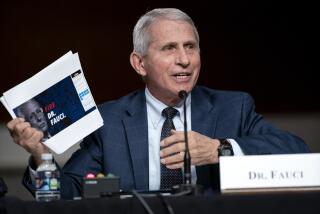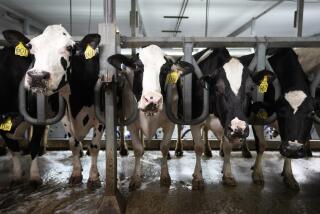Some Cipro With That Burger?
- Share via
BOSTON — This month, McDonald’s announced a public health breakthrough: Its meat and chicken suppliers must, by the end of 2004, stop using antibiotics to make animals grow faster. The fast-food giant’s new policy doesn’t go nearly far enough. But its market-driven half-measures are more visionary and practical than the timid regulations we’ve seen coming from the Food and Drug Administration.
Public health experts have long worried that producers are squandering human miracle drugs on animals that are not even sick. In 2001, the Union of Concerned Scientists, an environmental advocacy group, estimated that a whopping 70% of the antibiotics produced in the United States each year, nearly 25 million pounds, goes to food animals. On the farm, antibiotics -- many in the same classes as the most dependable human therapies-- are routinely mixed in with feed and water. Because small amounts are used, the weakest bacteria in the animals’ intestines perish, leaving the hardiest -- those best able to dodge medicine’s magic bullets -- to proliferate.
When people eat chicken, beef or pork tainted with those drug-resistant bugs, they can wind up with infections that our front-line weapons sometimes can’t touch. Drug resistance in the United States leads to 47,000 additional salmonella and campylobacter infections each year, according to a 2002 report from the Boston-based Alliance for the Prudent Use of Antibiotics. Such food-borne superbugs wreak all kinds of havoc. They are more virulent. They afflict more people because it takes fewer organisms to cause infection. They leave patients in the hospital longer. They especially threaten children, older people and individuals whose immune systems are weak, such as cancer or AIDS patients -- all groups likely to depend on antibiotics for survival.
For years, farmers and regulators were resolutely skeptical that antibiotics in animals could have downstream effects in people. Today, the link is richly documented, sometimes in surprising ways. In Muslim countries, for example, where pork is taboo, resistant food-borne bacteria in people are almost always identical to microbes found in poultry. In the U.S., one-fifth of human campylobacter infections are triggered by organisms that resist fluoroquinolones such as Cipro, a precious class of drugs that farmers started using to treat poultry disease only in 1995. A highly drug-resistant strain of salmonella in the U.S., DT-104, appears to have acquired its resistance genes from an astonishing source: Asian aquaculture, which has treated fish with antibiotics since the early 1980s. How did deadly fish genes land in American cattle and later in heedless consumers? Perhaps through contaminated fish meal fed to pigs and poultry, which themselves were later fed to domestic herds.
Farmers have been dosing their animals with antibiotic growth promoters because they thought the drugs would increase profits -- “value meals,” you might say, for the broiler house. But scientists never did explain the biology behind that idea. And antibiotics may not be economic miracle drugs after all. In 2001, a Danish study found that after farmers cut out growth promoters, their broiler chickens needed only 1% more feed to get to market size, a cost virtually offset by savings on antibiotics. A 2002 U.S. study by Perdue Farms found that drugged and drug-free birds fared about the same.
In a bit of veterinary revisionism, experts now say antibiotic growth promoters bring the biggest gains when flocks are living under crowded, filthy conditions -- and that when the milieu is comfortable and clean, they can do without. Even if the animals catch more infections after antibiotics are withdrawn, as would almost certainly occur in herds of young swine, the quantities of drugs needed to treat the infections are less than the amounts currently lavished to boost growth.
The McDonald’s decision is therefore a good first step. In the best of all worlds, Burger King, KFC and other fast-food chains would follow. But there are pitfalls. First, suppliers may flout the rule, continuing to use the drugs under the semantic guise of “disease prevention” rather than “growth promotion.” Second, because numbers collected by the company will continue to be proprietary, outside groups won’t be able to tell whether producers fulfilled their promise. Indeed, to the consternation of public health advocates, there are no solid data on animal antibiotic use -- which will make assessing any new policy a guessing game.
What our country really needs are far-reaching animal antibiotic rules shaped by science and set by government, not private industry. The World Health Organization, the Institute of Medicine, the American Medical Assn. and many other groups have called for a ban on those growth-promoting drugs that are essential in human medicine. The European Union approved a ban in 1998. But the FDA has been singularly meek. Its mealy-mouthed “framework” for evaluating antibiotics in food animals -- which categorizes animal drugs according to their importance in clinical medicine, then establishes “human health thresholds” for antibiotic resistance -- has done little to reduce use. Consumers who buy their chicken and meat in stores rather than under the golden arches have no guarantees that their next meal won’t be visited by microbial menace.
What would an enlightened federal policy look like? Above all, it would ban human antibiotics in food animals where there is no disease. It would save the most critical “last resort” human therapies for the most stubborn animal infections. It would collect real numbers on antibiotic use; underwrite research on growth-promoting alternatives, such as vaccines, probiotics (substances that promote the growth of healthy bacteria) and improved husbandry techniques; support development of new animal-only antibiotics; and help farmers change their ways, with financial incentives and education.
In human disease, most antibiotic-resistant infections are fostered by drugs prescribed to people, not by diseases acquired from bad food. But once drug resistance reaches a certain level in any realm, it’s tough to bring down. Europe has proved that political will can rein in resistant food-borne infections. To borrow a favorite phrase of President Bush, is this administration ready to “ride herd” alongside Mickey D?






